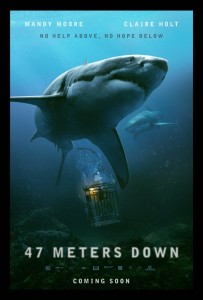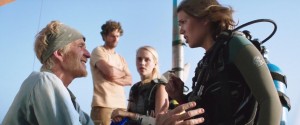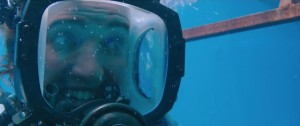 Like any other movie (and let’s just get this out of the way – this is a movie, not a film), “47 Meters Down” opens with a studio logo. Twentieth Century Fox? Nope. Paramount? Guess again. Warner Brothers? Give up? The correct answer — Entertainment Studios Motion Pictures, a company that earns its title by sheer virtue of how hilariously clumsy those four words are when spoken aloud. Try it right now; say it aloud and note its graceful music, like bricks falling from the tongue into an unflushed toilet. Now take this to the next logical step and imagine actually watching something this studio produced and ask yourself: can it possibly live up to the dedicated promise of an entertainment studio’s motion picture? One has to assume that whatever it was, it would be either the greatest or most terrible thing imaginable, like room temperature pizza, flip flops, or Enya.
Like any other movie (and let’s just get this out of the way – this is a movie, not a film), “47 Meters Down” opens with a studio logo. Twentieth Century Fox? Nope. Paramount? Guess again. Warner Brothers? Give up? The correct answer — Entertainment Studios Motion Pictures, a company that earns its title by sheer virtue of how hilariously clumsy those four words are when spoken aloud. Try it right now; say it aloud and note its graceful music, like bricks falling from the tongue into an unflushed toilet. Now take this to the next logical step and imagine actually watching something this studio produced and ask yourself: can it possibly live up to the dedicated promise of an entertainment studio’s motion picture? One has to assume that whatever it was, it would be either the greatest or most terrible thing imaginable, like room temperature pizza, flip flops, or Enya.
And then the movie actually begins, announced as if from the heavens by the artful and in no way gratuitous up-the-ass shot of a swimming Claire Holt (entertainment!), followed by the VERY BIG TITLE. Disregard what you’ve seen in previews, on the poster, or billboards nowhere: this isn’t called simply “47 Meters Down,” friends. This is “JOHANNES ROBERTS’ 47 METERS DOWN.” And because we’ve all heard of Johannes Roberts, his full-blown Lee Daniels-style narcissism is clearly the earned result of a stream of bona fide hit films and cancer vaccines. Entertainment Studios Motion Pictures is in it to win it.
Have you ever wanted to see Mandy Moore fight the world’s dumbest cartoon shark? Of course you have! Who wouldn’t? But before you begin pre-judging, you have to understand what sets this apart from some cheap, SyFy Channel movie with C-list actors, terrible effects, and more run time than plot, is that the fact that this is a cheap theatrical release with C-list actors, terrible effects, and more run time than plot. This is a film that teaches important lessons to rich white girls, like the perils of shark tank-diving, and having anything to do with Mexicans on their home turf. On the BIG SCREEN.
 Moore and Holt play vacationing sisters who decide that swimming with sharks will help Moore get over her traumatic breakup with her whatever seriously who cares. They go out to water on a filthy boat called the “Sea Esta” where Captain Matthew Modine accidentally leaves them stranded in a cage at the ocean floor when their support cable breaks (SEE: Mexicans). In order to build suspense, director Roberts creates all sorts of scenarios involving limited oxygen that never runs out despite the movie constantly threatening that it will, and an inescapable box that’s only inescapable when the movie needs it to be. At no time are we ever confused by what’s going on: the air pressure bar the characters carry, and by which they (and we) know how much air they have left, is helpfully marked AIR PRESSURE BAR. This is for the benefit of audience members who normally require their slightly quicker friends to explain movies to them in real time because they normally only watch movies like “47 Meters Down”. It almost comes as a surprise that the boat isn’t marked BOAT, the shark isn’t marked SHARK, or the production company isn’t named ENTERTAINMENT STUDIOS MOTION PICTURES. Oh, wait, never mind.
Moore and Holt play vacationing sisters who decide that swimming with sharks will help Moore get over her traumatic breakup with her whatever seriously who cares. They go out to water on a filthy boat called the “Sea Esta” where Captain Matthew Modine accidentally leaves them stranded in a cage at the ocean floor when their support cable breaks (SEE: Mexicans). In order to build suspense, director Roberts creates all sorts of scenarios involving limited oxygen that never runs out despite the movie constantly threatening that it will, and an inescapable box that’s only inescapable when the movie needs it to be. At no time are we ever confused by what’s going on: the air pressure bar the characters carry, and by which they (and we) know how much air they have left, is helpfully marked AIR PRESSURE BAR. This is for the benefit of audience members who normally require their slightly quicker friends to explain movies to them in real time because they normally only watch movies like “47 Meters Down”. It almost comes as a surprise that the boat isn’t marked BOAT, the shark isn’t marked SHARK, or the production company isn’t named ENTERTAINMENT STUDIOS MOTION PICTURES. Oh, wait, never mind.
We can be grateful for the fact that Moore doesn’t sing, but that doesn’t mean she shuts up, even underwater. The scuba masks are those kind that only exist in movies, where you can wear them and still speak clearly, and hear sounds like, for example, the shrill metallic banging on a steel cage one hundred and fifty feet below the surface. You can also remove the mask if needed, and put it back on without said mask filling with water, despite the absence of a discharge valve, thereby allowing a continuation of 1) life, 2) dialogue, and 3) this never-ending movie. The ability for our heroines to chatter on and on grants us the gift of ironic foreshadowing (“IT KIND OF TAKES YOUR BREATH AWAY, DOESN’T IT?” and “I COULD STAY DOWN HERE FOREVER!”), followed by endless sobbing/screaming/panting.
 Sometimes there’s a shark. Sometimes there’s two sharks. They’re never on screen for very long, because aside from looking really, really fake, it’s expensive to have them actually interact with the human characters in a believable way. As such, Moore and Holt take turns sneaking out of the cage, and then RAAAHR!, the shark appears, followed by our protagonists managing to completely out swim marine predators in a way that’s completely believable and in no way a complete and total brain-breaking insult to common sense. There’s literally more tension in the snapped cable. How do sharks miss chomping slow-moving and wounded people from a distance of a foot or so, you ask? Shut up and stop asking questions, idiot.
Sometimes there’s a shark. Sometimes there’s two sharks. They’re never on screen for very long, because aside from looking really, really fake, it’s expensive to have them actually interact with the human characters in a believable way. As such, Moore and Holt take turns sneaking out of the cage, and then RAAAHR!, the shark appears, followed by our protagonists managing to completely out swim marine predators in a way that’s completely believable and in no way a complete and total brain-breaking insult to common sense. There’s literally more tension in the snapped cable. How do sharks miss chomping slow-moving and wounded people from a distance of a foot or so, you ask? Shut up and stop asking questions, idiot.
The most successful aspect of “47 Meters Down” is the way in which we feel as though, like the characters, we too are trapped in an inescapable cage, forced to endure a miserable situation that never seems to end. Symbolism or life imitating art? Call it 2017’s best example of audience-interactive filmmaking. For this, Johannes Roberts earns his name over the title.
FUN FACT: If you take a shot every time Matthew Modine explains the concept of decompression sickness (aka “the bends”), you will die smarter than this movie.
Directed by Johannes Roberts
Written by Johannes Roberts and Ernest Riera
Rated PG-13 for sequences of intense, peril, bloody images, and brief strong language



This is fantastic and perfect: “One has to assume that whatever it was, it would be either the greatest or most terrible thing imaginable, like room temperature pizza, flip flops, or Enya.”